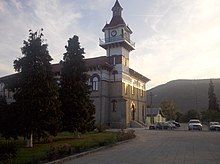Târgu Ocna
|
Târgu Ocna City of Okna Aknavásár |
||||
|
||||
| Basic data | ||||
|---|---|---|---|---|
| State : |
|
|||
| Historical region : | West Moldova | |||
| Circle : | Bacau | |||
| Coordinates : | 46 ° 17 ' N , 26 ° 37' E | |||
| Time zone : | EET ( UTC +2) | |||
| Height : | 263 m | |||
| Area : | 48.90 km² | |||
| Residents : | 11,300 (October 20, 2011) | |||
| Population density : | 231 inhabitants per km² | |||
| Postal code : | 605600 | |||
| Telephone code : | (+40) 02 34 | |||
| License plate : | BC | |||
| Structure and administration (as of 2016) | ||||
| Community type : | city | |||
| Structure : | 2 districts / cadastral municipalities: Poieni , Vâlcele | |||
| Mayor : | Ștefan Șilochi ( PSD ) | |||
| Postal address : | Str. Trandafirilor, no. 1 loc. Târgu Ocna, jud. Bacau, RO-605600 |
|||
| Website : | ||||
Târgu Ocna (German outdated town of Okna , Hungarian Aknavásár ) is a town in the Bacau district in Romania .
Geographical location
Târgu Ocna is located on the edge of the Eastern Carpathians in the valley of the Trotuș river between the mountains Berzunt in the north and Nemira in the south. The district capital Bacau is located about 40 km northeast.
history
The Târgu Ocna region has been populated since the Neolithic . The current place was formed from several villages, of which the oldest ( Stoeneşti ) was mentioned in 1410. The name Ocna has been traceable since 1599 and can be translated as “salt mine”. At the beginning of the 18th century the village of Ocna became a market town; During this time, the name addition Târgu (= "market") was added. Târgu Ocna has been a city since 1774. Until the middle of the 19th century it was the economic center of the Trotuş Valley, before it was overtaken by other cities ( Oneşti , Dărmăneşti , Comăneşti ).
In addition to trade, an important source of income for the city was salt mining. Tourism has been developing since the 19th century thanks to the salty medicinal springs and salt pans . In 1894 Târgu Ocna was declared a health resort.
During the First World War, the city was partially destroyed by fighting between German and Austro-Hungarian troops on the one hand and Romanian units on the other.
After the war and the communist seizure of power, a prison for political prisoners was established in Târgu Ocna . The tourist infrastructure was further expanded. Salt mining continues to play a major role in the city's economic life. In addition, oil production and wood extraction are important.
population
In the 2002 census, Târgu Ocna had 13,576 inhabitants, including 13,364 Romanians , 152 Roma , 19 Hungarians and 14 Armenians .
traffic
Târgu Ocna has two stations for passenger traffic on the Sfântu Gheorghe – Adjud railway line , with express trains stopping at Saline station, whereas Târgu Ocna station is only served by local trains. There are also good bus connections to the nearby spa town of Slănic-Moldova . The national road ( drum național ) DN 12A from Oneşti to Miercurea Ciuc runs through the city .
Attractions
- Mina Salina (sanatorium for respiratory diseases)
- Măgura Park with seven mineral springs
- Răducanu Monastery (17th / 18th century)
- Wooden church Cuvioasa Paraschiva (late 16th century)
- Sfântul Gheorghe wooden church (1761)
- Măgura Ocnei monastery complex (16th century, reconstructed in 1990)
- Remains of the Dacian fortress Utidava
- historical Museum
Personalities
- Gabriela Adameşteanu (* 1942), writer
Web links
Individual evidence
- ↑ 2011 census in Romania ( MS Excel ; 1.3 MB)
- ↑ a b Tourismguide.ro, accessed on December 31, 2008
- ^ Website of the city, accessed on December 31, 2008 ( Memento of March 6, 2010 in the Internet Archive )
- ^ Dennis Deletant : Ceauşescu and the Securitate. Coercion and dissent in Romania, 1965-1989 . ME Sharpe, New York NY 1995, ISBN 1-56324-633-3 , pp. 29 .
- ↑ 2002 census, accessed December 31, 2008


